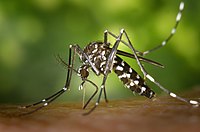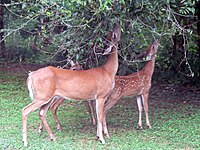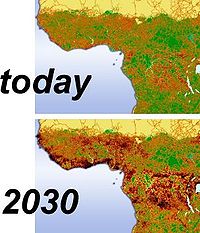
A spatial theory for emergent multiple predator–prey interactions in food webs
Sign Up to like & getrecommendations! Published in 2017 at "Ecology and Evolution"
DOI: 10.1002/ece3.3250
Abstract: Abstract Predator–prey interaction is inherently spatial because animals move through landscapes to search for and consume food resources and to avoid being consumed by other species. The spatial nature of species interactions necessitates integrating spatial… read more here.
Keywords: predator prey; multiple predator; emergent multiple; predator ... See more keywords

Keystone nonconsumptive effects within a diverse predator community
Sign Up to like & getrecommendations! Published in 2017 at "Ecology and Evolution"
DOI: 10.1002/ece3.3392
Abstract: Abstract The number of prey killed by diverse predator communities is determined by complementarity and interference among predators, and by traits of particular predator species. However, it is less clear how predators' nonconsumptive effects (NCEs)… read more here.
Keywords: mosquito larvae; community; diverse predator; nonconsumptive effects ... See more keywords

Hunting‐mediated predator facilitation and superadditive mortality in a European ungulate
Sign Up to like & getrecommendations! Published in 2018 at "Ecology and Evolution"
DOI: 10.1002/ece3.3642
Abstract: Abstract Predator‐prey theory predicts that in the presence of multiple types of predators using a common prey, predator facilitation may result as a consequence of contrasting prey defense mechanisms, where reducing the risk from one… read more here.
Keywords: prey; predator facilitation; hunting mediated; predator ... See more keywords

Co‐occurrence dynamics of endangered Lower Keys marsh rabbits and free‐ranging domestic cats: Prey responses to an exotic predator removal program
Sign Up to like & getrecommendations! Published in 2018 at "Ecology and Evolution"
DOI: 10.1002/ece3.3954
Abstract: Abstract The Lower Keys marsh rabbit (Sylvilagus palustris hefneri) is one of many endangered endemic species of the Florida Keys. The main threats are habitat loss and fragmentation from sea‐level rise, development, and habitat succession.… read more here.
Keywords: predator removal; marsh rabbits; occurrence; site ... See more keywords

Behavioral responses to conspecific mobbing calls are predator‐specific in great tits (Parus major)
Sign Up to like & getrecommendations! Published in 2019 at "Ecology and Evolution"
DOI: 10.1002/ece3.5467
Abstract: Abstract When facing a predator, animals need to perform an appropriate antipredator behavior such as escaping or mobbing to prevent predation. Many bird species exhibit distinct mobbing behaviors and vocalizations once a predator has been… read more here.
Keywords: parus major; behavioral responses; mobbing calls; tits parus ... See more keywords

Damselfly eggs alter their development rate in the presence of an invasive alien cue but not a native predator cue
Sign Up to like & getrecommendations! Published in 2021 at "Ecology and Evolution"
DOI: 10.1002/ece3.7729
Abstract: Abstract Biological invasions are a serious problem in natural ecosystems. Local species that are potential prey of invasive alien predators can be threatened by their inability to recognize invasive predator cues. Such an inability of… read more here.
Keywords: damselfly; cue; egg; predator ... See more keywords

Beyond the encounter: Predicting multi‐predator risk to elk (Cervus canadensis) in summer using predator scats
Sign Up to like & getrecommendations! Published in 2022 at "Ecology and Evolution"
DOI: 10.1002/ece3.8589
Abstract: Abstract There is growing evidence that prey perceive the risk of predation and alter their behavior in response, resulting in changes in spatial distribution and potential fitness consequences. Previous approaches to mapping predation risk across… read more here.
Keywords: predation risk; predation; predator; scat based ... See more keywords

Revisiting the influence of learning in predator functional response, how it can lead to shapes different from type III
Sign Up to like & getrecommendations! Published in 2022 at "Ecology and Evolution"
DOI: 10.1002/ece3.8593
Abstract: Abstract Predator/parasitoid functional response is one of the main tools used to study predation behavior, and in assessing the potential of biological control candidates. It is generally accepted that predator learning in prey searching and… read more here.
Keywords: predator; functional response; response; type iii ... See more keywords

Cats and dogs: A mesopredator navigating risk and reward provisioned by an apex predator
Sign Up to like & getrecommendations! Published in 2022 at "Ecology and Evolution"
DOI: 10.1002/ece3.8641
Abstract: Abstract Successfully perceiving risk and reward is fundamental to the fitness of an animal, and can be achieved through a variety of perception tactics. For example, mesopredators may “directly” perceive risk by visually observing apex… read more here.
Keywords: predator; risk; risk reward; mountain lions ... See more keywords

Evolutionary change in metabolic rate of Daphnia pulicaria following invasion by the predator Bythotrephes longimanus
Sign Up to like & getrecommendations! Published in 2022 at "Ecology and Evolution"
DOI: 10.1002/ece3.9003
Abstract: Abstract Metabolic rate is a trait that may evolve in response to the direct and indirect effects of predator‐induced mortality. Predators may indirectly alter selection by lowering prey densities and increasing resource availability or by… read more here.
Keywords: ecology; daphnia pulicaria; metabolic rate; predator ... See more keywords

Camera trap data suggest uneven predation risk across vegetation types in a mixed farmland landscape
Sign Up to like & getrecommendations! Published in 2022 at "Ecology and Evolution"
DOI: 10.1002/ece3.9027
Abstract: Abstract Ground‐nesting farmland birds such as the grey partridge (Perdix perdix) have been rapidly declining due to a combination of habitat loss, food shortage, and predation. Predator activity is the least understood factor, especially its… read more here.
Keywords: farmland; predation risk; vegetation; predation ... See more keywords